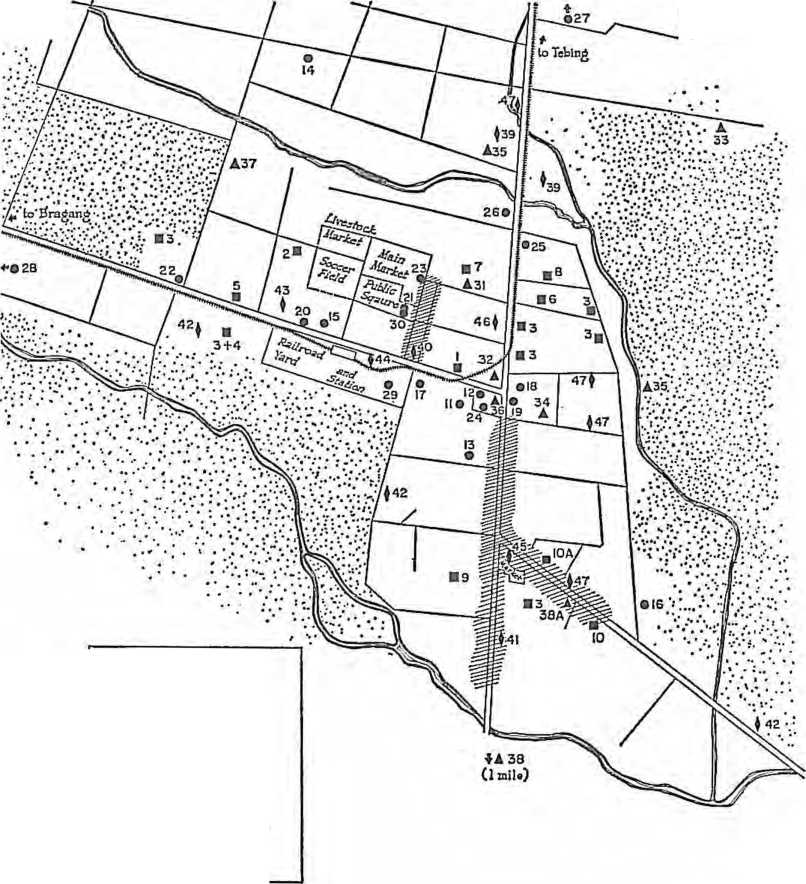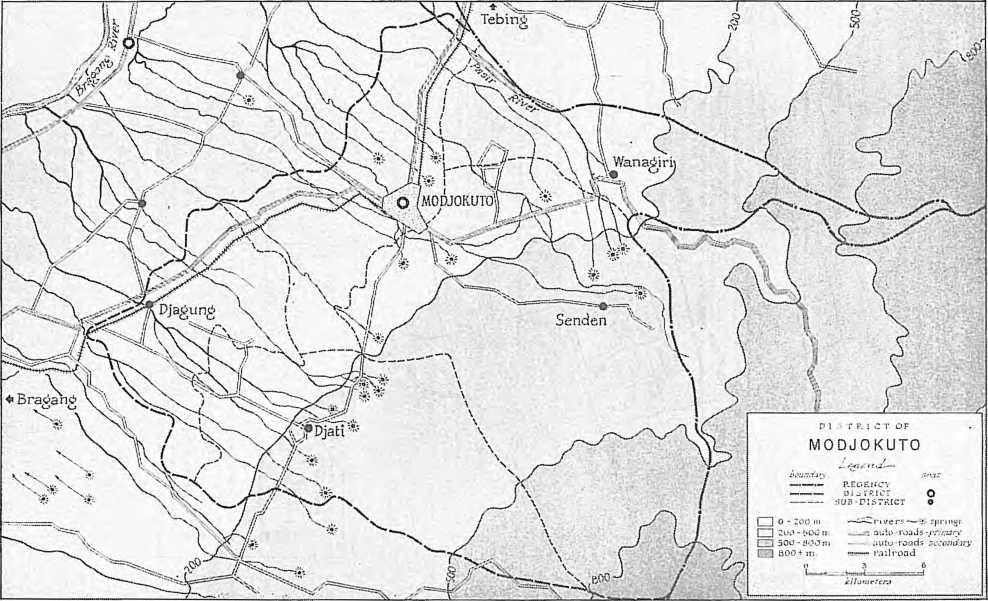*$47
(Jímile)

TUE TOWM OF
MODJOKUTO
[Only the more important terms appearing in the text are listed, each with a single reference to the place where it is most completely explicated. Terms followed by (/) are Indonesian; the rest are either Javanese or both Javanese and Indonesian.]
|
abangan, 5 |
djadjan, 48 |
|
abogé, 380n |
Djagalan, 78 |
|
aku, 310 |
djago-djagoan, 61 |
|
alus, 232 |
djapa, 43 |
|
andap-asor, 243 |
djaranan, 262 |
|
apem, 71 |
djenang, 49 djènggès, 107 |
|
Babad Tanah Djawi, 23 |
djim, 17 |
|
babaran, 45 |
djimat, 103 |
|
bangsa alus, 17 |
djiwa kotong, 98 |
|
bangun nikah, 84 |
djogèd,'261 |
|
batik, 261 |
doa, 216 |
|
batin, 232 |
donga, 42 |
|
betfaja, 283 |
dongèng, 262 |
|
berkat; see tondjokan bersih désa, 82 |
^ukun, 86 |
|
4ukun baji, 42 | |
|
bioskop (I), 262 |
¿ukun pidjet, 52 |
|
bong; see tjalak |
4ukun tiban, 99 |
|
brokokan; see babaran Bruwah, 79 |
duwé gawé, 61 |
|
bubak, 54 bubur sengkala, 40 |
étok-étok, 245 |
|
buwuh, 66 |
gambusan, 156 gamelan, 261 |
|
chotbah, 201 |
gela, 312 |
|
chotib, 202 |
gendam, 108 gentfing, 278 |
|
dalang, 262 |
gendruwo, 18 |
|
çlangsah, 282 |
guna, 108 |
|
çlanjang, 23 danjang désa, 82 |
guru, 328 |
|
[jarah kotor, 98 darus, 220 |
hadji, 204 |
|
^emit, 24 |
idjab, 56 |
iklas, 240 ilrau, 88 ilmu djawi, 339 imam, 202 islaman; see sunatan
kagèt, 312
kampir-kampiran, 20 kasar, 232 kataman, 178 kauman, 132 kebupaten (I), 4 kedjawèn, 339 kékah, 72
kembang majang, 55 kemomong, 21 kençlurèn; see slametan kepanggihan, 53 kesurupan, 20 kesusastraan (I), 262 ketib, 202 ketjamatan (I), 4 ketoprak, 291 kewedanan (I), 4 kijaji, 134n kirab, 60n klèçlèk, 262 kolot, 130 krama, 249 kris, 43 ku^ung, 57 kumaran, 26 kunir, 46 kuno, 112
kupat, 79 Kupatan, 79 kurang darah, 98 kutjung, 50
lagu, 262 lair, 232 lajatan, 68 lakon, 261 Iamaran, 53 langgar, 181 Lara Kidul, 28 lelembut, 16 lepet, 79 ludrug, 261 lurah, 26
madrasah, 187 madya, 249 Maleman, 78 manggulan, 52 mantèn, 57 manten pangkon, 61 mantri, 105 mas kawin, 56 masuk angin, 99 Mauludan, 78 mBah Buda, 24 Megengan, 78 memedi, 16 mentèk, 17 merbot, 202 midadarèni, 55 modéren, 112 modín, 206 mualimin, 189 murid, 329
nadjir, 201 naga, 32 naib, 202 ngebokné, 44 ngèsti, 322 ngoko, 253 nontoni, 54 nuraga, 108 nuwun, 322
orkes, 262
panas mlebu, 99 paningset, 54 pantjakan, 50 Pantjasila (I), 115
paru-paru, 52 pasa, 77n pasaran, 47 pengaosan, 168 penghulu, 132 penindjoan; see kirab pentjak, 156 pesantrèn; see pon^ok petungan, 30 pisatji, 17 pitji (I), 57 pitonan, 49 pitulung, 95 pontfok, 177 prijaji, 6 pulung, 26 pundèn, 24 pundjung tumplek, 54 pus aka, 301
ramé, 49 rasa, 238 Redjeban, 78 rudjak, 40 rudjuk, 203 rukun, 61
sabar, 241 sadjèn, 41 salaman, 58 sampurna, 75 santèt, 107
santri (religious variant), 5 santri (religious student), 178n
sarak, 199 sasrahan, 54 sawanan, 19 sekolah, 190 selapanan, 38 sembah, 58n sembahjang; see solat semèdi, 325 sentong tengah, 55 sétan, 19 sétanan, 21 sétan gundul, 18 sikir, 107 singsèh, 103 sirep, 108 slamet, 14 slametan, 11 slametan metik, 81 slén^ang, 58
solat, 216 srimpi, 283 suluk, 279 sunatan, 51 sundel bolong, 18 susuk, 94
tajuban, 299 takdir, 150 talak, 203 taunan, 38 tapa, 325 tarékat, 182 tegel, 69 tèlkim, 71 telonan, 38 temantèn pari, 81 tembang, 261 tenung, 107 terbangan, 156 tingkeban, 39 tjalak, 51 tjikal-bakal, 26n tjotjog, 31 toh watu, 44 tondjokan, 49n trawèh, 220 trima, 241 trowongan, 79 tujul, 16
tukang metik, 81 tukang paras, 57 tukar tjintjin (I), 53 tumbak sèwu, 49
udjub, 12 ulama, 121 ummat, 128
wajang, 261
wajang wong, 285
wakap, 203
wali (saint), 39
wali (legal guardian), 56
wedon, 17
welad, 45
wesi tawa, 52
wèwèhan, 80n
windu, 31
wiwit sawah, 81
wukuh, 31
zakat fitrah, 173
MAPS
KEY TO MAP OF THE TOWN OF MODJOKUTO
SCHOOL BUILDINGS Government Schools
1 Secondary School for Teachers
2 Technical Secondary School
3 Elementary schools (six grades)
Private Schools
4 “Ngèsti Tunggal," a local foundation and secondary school
5 Taman Siswa elementary and secondary school
6 Muhammadijah elementary school, secondary school and secondary school for teachers
7 PSII elementary school
8 Nahdatul Ulama religious teachers school
9 Typing school
10 Catholic elementary school 10A Chinese school
GOVERNMENT BUILDINGS
11 District Office (Kewedanan)
12 Subdistrict Office (Ketjamatan) and Information Office
13 Village Office of Modjokuto (Kelurahan)
14 Village Office of Sumbersari (Kelurahan)
15 Regency Police Headquarters
16 Regency Police Barracks
17 Army Training School
18 Regency Hospital
19 Post Office and Telephone and Telegraph Office
20 Electricity Office
21 Department of Public Works: Roads and Buildings
22 Department of Public Works: Irrigation Office
23 Market Office and Bank
24 Pawn House
25 Abattoir
26 Poor House
27 Forestry Office
28 Agricultural Extension Service
29 Railroad Office
30 Department of Health Office
RELIGIOUS INSTITUTIONS
31 Mosque and Office for Religious Affairs
32 Village shrine at banyan tree
33 Dutch Reformed Church
34 Pentacostal Church
35 Cemetery
36 Memorial Cemetery for Heroes of the Revolution
37 Private cemetery, “Ngèsti Tunggal”
38 Chinese cemetery 38A Bethel Church
OTHER BUILDINGS
39 Private Dutch hospital
40 Motion picture theater
41 Theater ( Wajang Wong and Sandiwara)
42 Rice mill
43 Public Meeting Hall (Gedung Nasional)
44 Railroad Union Hall
45 Bus and Jitney Station
46 Orphanage (Muhammadijah)
47 Ethnographers’ houses
48 Federation of Chinese Associations (CHTH)
-$47 (2 miles)
*$47
(Jímile)

TUE TOWM OF
MODJOKUTO
□ Residential limd E3 Rice fields Cl Business district
— Primary roads
— Secondaire roadfl B School buildings
0 Government building.» A Religious institutions Q Other buildings

Anthropology/Comparative Religions
Clifford Geertz "[The Religion of Java] makes new and important contributions to our understanding of Javanese life; it is well-documented; it is clearly written; it is perceptively and creatively conceived."—Cora Du Bois, American Anthropologist
Written with a rare combination of analysis and speculation, this comprehensive study of Javanese religion is one of the few books on the religion of a non-Western people which emphasizes variation and conflict in belief as well as similarity and harmony. The reader becomes aware of the intricacy and depth of Javanese spiritual life and the problems of political and social integration reflected in the religion.
The Religion of Java will interest specialists in Southeast Asia, anthropologists and sociologists concerned with the social analysis of religious belief and ideology, students of comparative religion, and civil servants dealing with governmental policy toward Indonesia and Southeast Asia.
"Here is a masterful study, by a well-trained anthropologist, of religious beliefs and practices as observed in a small town in East Central Java. . . . The treatment is thorough, erudite and dynamic. Here is a model that should be followed by all students of religion; a book that should be read for its basic insights into religion, even if the reader has no special reason to take interest in the people of Java. Needless to say, for a student of Indonesia this work is a major contribution and a real treat."—Library Journal
"To illustrate this complexity and to describe plastically and convincingly both separateness and interaction, diversity and unity of the three principal strata of Javanese Islam is the purpose and achievement of the present volume. . . . The documentation is rich and varied."—G. E. von Grunebaum, American Journal of Sociology
Clifford Geertz is the Harold S. Linder Professor of Social Science at the Institute for Advanced Study in Princeton. He is the author of many books, including Islam Observed and Peddlars and Princesand, with Hildred Geertz, Kinship in Bali (all published by the University of Chicago Press).
The University of Chicago Press
WWW.PRESS.UCHICAGO.EDU This book was produced as a digital reprint.
ISBN ^70-0-221,-20510-0
